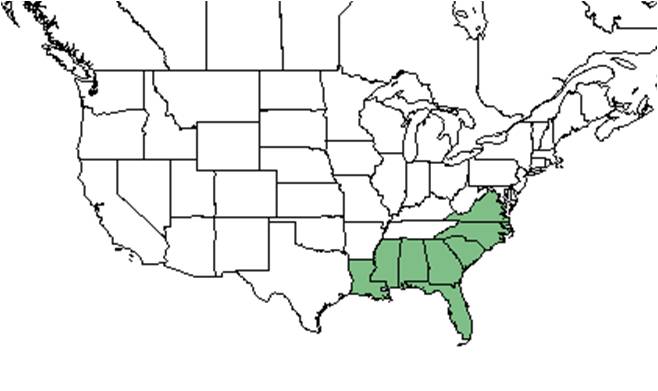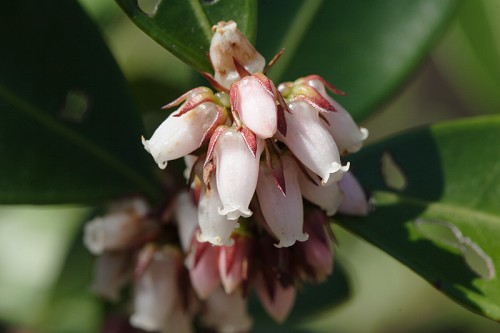Difference between revisions of "Lyonia lucida"
Lsandstrum (talk | contribs) (→Ecology) |
Lsandstrum (talk | contribs) (→Habitat) |
||
| Line 29: | Line 29: | ||
==Ecology== | ==Ecology== | ||
===Habitat=== | ===Habitat=== | ||
| − | ''L. lucida'' responds positively to soil disturbance by heavy silvilculture in North Carolina.<ref>Cohen, S., R. Braham, and F. Sanchez. (2004). Seed Bank Viability in Disturbed Longleaf Pine Sites. Restoration Ecology 12(4):503-515.</ref> | + | ''L. lucida'' responds positively to soil disturbance by heavy silvilculture in North Carolina.<ref>Cohen, S., R. Braham, and F. Sanchez. (2004). Seed Bank Viability in Disturbed Longleaf Pine Sites. Restoration Ecology 12(4):503-515.</ref> It also responds both positively and negatively to soil disturbance by clearcutting and roller chopping in North Florida.<ref>Lewis, C.E., G.W. Tanner, and W.S. Terry. (1988). Plant responses to pine management and deferred-rotation grazing in north Florida. Journal of Range Management 41(6):460-465.</fef> |
<!--Natural communities, human disturbed habitats, topography, hydrology, soils, light, fire regime requirements for removal of competition, etc.--> | <!--Natural communities, human disturbed habitats, topography, hydrology, soils, light, fire regime requirements for removal of competition, etc.--> | ||
| + | |||
===Phenology=== <!--Timing off flowering, fruiting, seed dispersal, and environmental triggers. Cite PanFlora website if appropriate: http://www.gilnelson.com/PanFlora/ --> | ===Phenology=== <!--Timing off flowering, fruiting, seed dispersal, and environmental triggers. Cite PanFlora website if appropriate: http://www.gilnelson.com/PanFlora/ --> | ||
''L. lucida'' has been observed flowering from January to May and in November and December with peak inflorescence in April.<ref>Nelson, G. [http://www.gilnelson.com/ PanFlora]: Plant data for the eastern United States with emphasis on the Southeastern Coastal Plains, Florida, and the Florida Panhandle. www.gilnelson.com/PanFlora/ Accessed: 12 DEC 2016</ref> | ''L. lucida'' has been observed flowering from January to May and in November and December with peak inflorescence in April.<ref>Nelson, G. [http://www.gilnelson.com/ PanFlora]: Plant data for the eastern United States with emphasis on the Southeastern Coastal Plains, Florida, and the Florida Panhandle. www.gilnelson.com/PanFlora/ Accessed: 12 DEC 2016</ref> | ||
Revision as of 17:59, 17 July 2019
| Lyonia lucida | |
|---|---|

| |
| Photo by John R. Gwaltney, Southeastern Flora.com | |
| Scientific classification | |
| Kingdom: | Plantae |
| Division: | Magnoliophyta - Flowering plants |
| Class: | Magnoliopsida – Dicotyledons |
| Order: | Ericales |
| Family: | Ericaceae |
| Genus: | Lyonia |
| Species: | L. lucida |
| Binomial name | |
| Lyonia lucida (Lam.) K. Koch | |

| |
| Natural range of Lyonia lucida from USDA NRCS Plants Database. | |
Common names: Fetterbush lyonia; Shining fetterbush
Contents
Taxonomic notes
Synonyms: Desmothamnus lucidus (Lamarck) Small; Neopieris nitida (Bartram ex Marshall) Britton
Description
A description of Lyonia lucida is provided in The Flora of North America.
Distribution
Ecology
Habitat
L. lucida responds positively to soil disturbance by heavy silvilculture in North Carolina.[1] It also responds both positively and negatively to soil disturbance by clearcutting and roller chopping in North Florida.Cite error: Closing </ref> missing for <ref> tag
Pollination
The following Hymenoptera families and species were observed visiting flowers of Lyonia lucida at Archbold Biological Station: [2]
Apidae: Bombus impatiens
Halictidae: Lasioglossum placidensis
Conservation and management
Cultivation and restoration
Photo Gallery
Lyonia lucida Photo by John R. Gwaltney, Southeastern Flora.com
Flowers of Lyonia lucida Photo by John R. Gwaltney, Southeastern Flora.com

